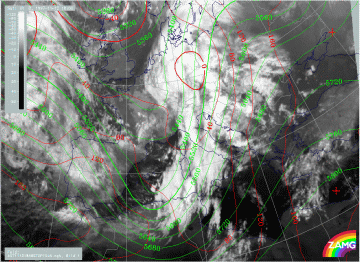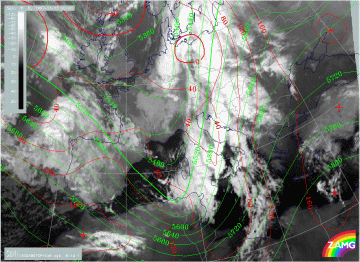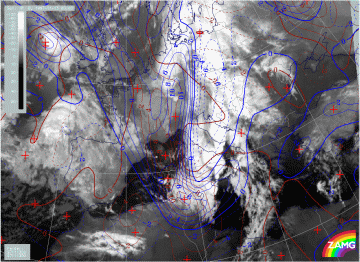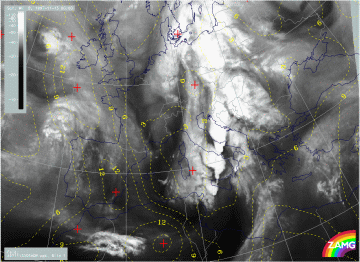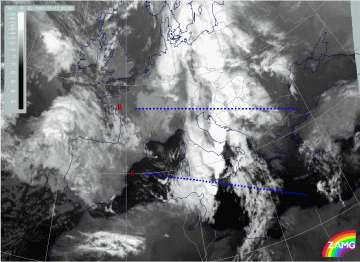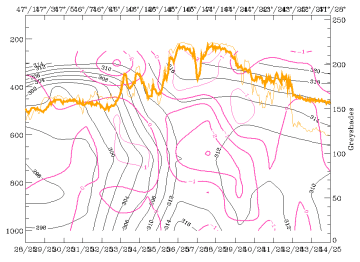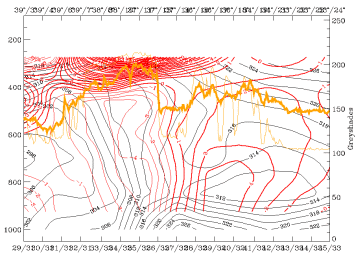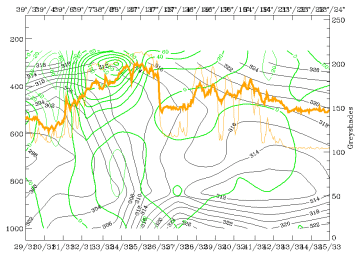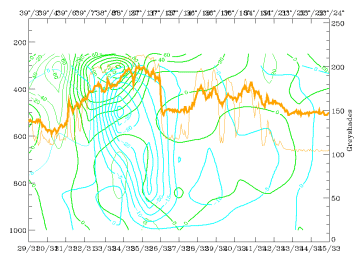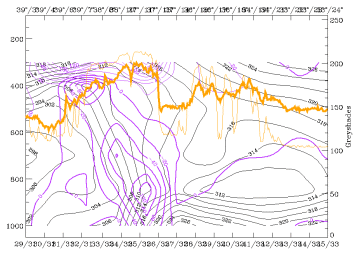Overview and frontal situation
|
12 November 1997/18.00 UTC - Meteosat IR image; red: height contours 1000 hPa, green: height contours 500 hPa
|
13 November 1997/00.00 UTC - Meteosat IR image; red: height contours 1000 hPa, green: height contours 500 hPa
|
There is a zone of low pressure areas close to the surface (right image) from the former Wave over north Germany and east Poland across east Austria and the Adriatic Sea to an extended trough south of Sicily. The latter is in front of the Cold Front band but on the rear side of the newly formed fibrous cloud band. Such a surface low could already be recognised six hours before (left image) but only now can it be associated with this new cloud band.
|
13 November 1997/00.00 UTC - Meteosat IR image; blue: thermal front parameter (TFP) 500/850 hPa, green: equivalent thickness 500/850
hPa, red: temperature advection - WA 1000 hPa
|
|
The upper level trough is very distinct and reaches from the Netherlands southward to Tunisia where curvature vorticity is very pronounced (not shown here). This curvature vorticity leads to the spiral form of the frontal cloud band there which is, however, still not a sign for a classical Wave development as can be concluded from the TA field in the image above. On the contrary, the synoptic situation there seems to be connected with the development of the eastern fibrous cloud band which is under the influence of WA.
The maximum line of the TFP, which represents the conventional front line, extends from north Tunisia across the Adriatic Sea and west Croatia to west Hungary and further northward. It is accompanied from Sicily northward as far as Croatia by extensive Cb and MCS developments. These will be discussed together with the synoptic environment in a separate chapter (compare Development of Thunderstorms and MCSs During the Whole Period).
|
13 November 1997/00.00 UTC - Meteosat IR image; yellow: isotachs 300 hPa, red: vorticity advection 300 hPa
|
13 November 1997/00.00 UTC - Meteosat IR image; blue: shear vorticity 300 hPa, brown: curvature vorticity 300 hPa
|
|
13 November 1997/00.00 UTC - Meteosat WV image; yellow: Showalter index 500/850 hPa
|
|
In the image above (left image top) isotachs and PVA at 300 hPa are superimposed. Two or even three different cloud situations are explained by an interpretation of these parameter fields:
- There is still a huge PVA maximum superimposed on the front between Tunisia and Sardinia which is now produced by both the shear in the left exit region and the curvature in the pronounced upper level trough (right image top);
- But as a continuation from six hours earlier, a second jet streak has developed which extends from Tunisia eastward; it seems to be
responsible for two effects:
- Dry air propagating ahead of the Cold Front and causing the very black area in the WV image there (left image bottom)
- A lobe of PVA extending from approximately 39N/12E - south Italy which is in the left exit region of the new jet streak and mainly caused by shear (right image top).
|
13 November 1997/00.00 UTC - Meteosat IR image; position of vertical cross sections R and S indicated
|
|
In the image above two vertical cross sections are indicated which are discussed in more detail in the following paragraphs: the northern one crosses Slovenia and Croatia (cross section R), the southern one crosses Sicily (cross section S).
|
13 November 1997/00.00 UTC - Vertical cross section R; black: isentropes (ThetaE), red thin: temperature advection - CA, red thick:
temperature advection - WA, orange thin: IR pixel values, orange thick: WV pixel values
|
13 November 1997/00.00 UTC - Vertical cross section R; black: isentropes (ThetaE), magenta thin: divergence, magenta thick:
convergence, orange thin: IR pixel values, orange thick: WV pixel values
|
The most important features in the northern cross section R is the very steep frontal surface with superadiabatic inclination in the lower layer and consequently WA up to 800 hPa with CA above. This is a typical condition for an unstable situation. Further to this, there is significant convergence not within but in front of the frontal surface. Both features may play an important role for the intensive thunderstorm development there.
|
13 November 1997/00.00 UTC - Vertical cross section S; black: isentropes (ThetaE), red thin: temperature advection - CA, red thick:
temperature advection - WA, orange thin: IR pixel values, orange thick: WV pixel values
|
13 November 1997/00.00 UTC - Vertical cross section S; black: isentropes (ThetaE), magenta thin: divergence, magenta thick:
convergence, orange thin: IR pixel values, orange thick: WV pixel values
|
The southern vertical cross section S shows rather classical Cold Front conditions, but somewhat different conditions for the thunderstorm development there. In the left and right images the frontal surface can be localised from 39N/08E at about 350 hPa down to the surface at 37N/11E where also a thunderstorm is reported. But the frontal surface is under CA. Differences can also be recognized in the convergence which accompanies only the frontal zone with maximal values. The thunderstorm report fits very well to the convergence accompanying the low frontal zone and to the PVA maximum increasing with height (left image below).
|
13 November 1997/00.00 UTC - Vertical cross section S; black: isentropes (ThetaE), green thick: vorticity advection - PVA, green thin:
vorticity advection - NVA, orange thin: IR pixel values, orange thick: WV pixel values
|
13 November 1997/00.00 UTC - Vertical cross section S; cyan thick: vertical motion (omega) - upward motion, cyan thin: vertical motion
(omega) - downward motion, green thick: vorticity advection - PVA, green thin: vorticity advection - NVA, orange thin: IR pixel values,
orange thick: WV pixel values
|
The right image above shows the connection between PVA and omega. There are two maxima on top of the frontal zone: from the surface up to about 650 hPa which seems to be connected with the convergence cell, and a second one centred at 500 hPa which is connected with the PVA maximum.
|
13 November 1997/00.00 UTC - Vertical cross section; black: isentropes (ThetaE), lilac: Q-Vector (normal component), orange thin: IR
pixel values, orange thick: WV pixel values
|
|
The image above finally shows that there is further frontogenesis in this area of the cloud band, a situation which also has continued from six hours before.
